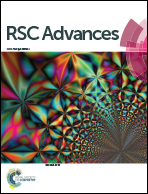Green synthesis of gold nanoparticles from Manilkara zapota L. extract and the evaluation of its intrinsic in vivo antiarthritic potential†
Abstract
The plant Manilkara zapota belongs to the family Sapotaceae and is commonly known as Chiku in Pakistan. Traditionally, M. zapota is used in pulmonary diseases, diarrhea, rheumatism, hemorrhage, and ulcers. There is no study available on the in vivo antiarthritic activity of M. zapota and its gold nanoparticles (AuNPs). The aim of this study is to evaluate the in vivo acute and sub-acute antiarthritic activity of aqueous extract of M. zapota and its biosynthesized gold nanoparticles (AuNPs). Plant-induced reduction method was used for the synthesis of AuNPs. The synthesized AuNPs were characterized via UV, FTIR, SEM, and zeta potential measurements and were optimized by screening various parameters including time, temperature, pH, and salt concentration. Arthritis in rats was induced by Freund's Complete Adjuvant (FCA) injection in hind paw. The antiarthritic effect was evaluated by the determination of paw volume, joint diameter, latency time, hematological, biochemical parameters, antioxidant biomarkers, TNF-α level, and radiological evaluation. The aqueous extract and nanoparticles significantly decreased the paw volume, joint diameter, and significantly increased latency time as compared to the FCA-induced arthritic group. They significantly normalized the hematological, biochemical parameters, and oxidative stress biomarkers in comparison to the arthritic group. They also significantly decreased the TNF-α level when assessed against the arthritic group. Radiological evaluation confirmed the antiarthritic effect of the aqueous extract and nanoparticles of M. zapota leaf extract. It is concluded that the aqueous extract and nanoparticles of M. zapota possess significant analgesic, antiarthritic, and anti-inflammatory activity. However, nanoparticles possess more pronounced antiarthritic activity as compared to the aqueous extract. Moreover, free radical scavenging action and TNF-α reduction showed a prominent role in their antiarthritic activity. Further, investigation is underway to identify the active phytochemical constituent responsible for the antiarthritic activity.



 Please wait while we load your content...
Please wait while we load your content...